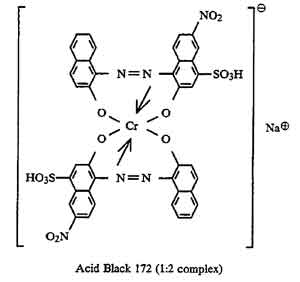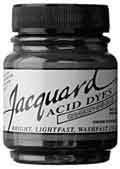I have about 10m of natural wool to dye black, I bought a dye and tried a small off cut it turned out brown. So, to dye a natural wool, cream in colour, black, where did I go wrong and, more importantly, what do you suggest?
Name: Diane
Message: Hi,
I have about 10m of natural wool to dye black, I bought a dye and tried a small off cut it turned out brown. So, to dye a natural wool, cream in colour, black, where did I go wrong and, more importantly, what do you suggest? I look forward to hearing from you.
The first rule in dyeing anything black, regardless of what dye you use, is to use MORE DYE. It takes at least two to four times as much dye to get black as you would use for any other color.
You will also need to use an acid, such as vinegar or citric acid, when dyeing wool, carefully following a good recipe for the particular dye that you have. The amount required depends on the type of dye you are using. The manufacturers for Tintex Hot Water dye in Australia suggests using 1 cup (250 ml) of white vinegar per 10 liters of water when dyeing wool, silk, or nylon. You must use heat when dyeing wool, bringing the dyebath to a simmer and holding it for half an hour to an hour, depending on the dye—ordinary washing machine temperatures will not do—and be sure to use a large volume of water in order to get smooth, even solid coverage with your dye.


The next question is, what kind of dye are you using? If you are using an all-purpose dye (such as Rit® or Tintex® all-purpose dyes), then what you've seen is what many people have reported already for this class of dye. You will probably get a reasonably good black color if you use four boxes of dye for every pound of wool, though. The acid dyes contained in these all-purpose dyes are said to be leveling acid dyes, which are good for leveling (getting a perfectly smooth even color) but bad for washfastness (wash separately by hand in cool water only, or dry clean). For more washfast results, or for more satisfactory results in general, I would suggest that you buy an acid dye that is specifically designed for wool and other protein fibers, rather than an all-purpose dye.
The best dye for getting a rich, dark black on wool is the Lanaset Jet Black, also sold under the names Telana or Sabraset. (See "About Lanaset Dyes" for more information about these dyes.) It is a 1:2 metal complex dye with high lightfastness, which, unlike other acid dyes, is washfast even at 140°F. Most acid dyes are washfast only up to 105°F. The Lanaset Jet Black is actually a mixture of two different black dyes, but it does not separate out in direct dye application; it acts more like a single-hue, unmixed dye. Lanaset dyes are expensive, almost as expensive as all-purpose dyes, but they are widely agreed to be worth it. You should use 25 grams of this black dye per pound of wool, according to ProChem's instructions.

The black in PRO Chemical & Dye's Washfast Acid Dyes line is also a 1:2 metal complex dye; it is a single-hue, unmixed dye, Colour Index Acid Black 172, so it does not separate out in direct dye application. Acid Black 172 is actually one of the two dyes in the Lanaset Jet Black dye. It's much more economical than all-purpose dyes, as it is more concetrated. It is rated as 7 (out of 8) for lightfastness, which is good, and has been rated at a washfastness of 4-5 (out of 5) in warm water of 105°F. As
with the Jet Black Lanaset dye, you should use 25 grams of this black dye per
pound of wool. Using less dye per pound of wool will produce a brownish or
reddish color.
As
with the Jet Black Lanaset dye, you should use 25 grams of this black dye per
pound of wool. Using less dye per pound of wool will produce a brownish or
reddish color.
The black in Jacquard 639 Acid Black dye is a mixture; you are supposed to use up to three ounces (85 grams) of this dye per pound of wool in order to get a nice deep black, according to Jacquard Products' instructions.
(Please help support this web site. Thank you.)
Message: Hi,
I have about 10m of natural wool to dye black, I bought a dye and tried a small off cut it turned out brown. So, to dye a natural wool, cream in colour, black, where did I go wrong and, more importantly, what do you suggest? I look forward to hearing from you.
The first rule in dyeing anything black, regardless of what dye you use, is to use MORE DYE. It takes at least two to four times as much dye to get black as you would use for any other color.
You will also need to use an acid, such as vinegar or citric acid, when dyeing wool, carefully following a good recipe for the particular dye that you have. The amount required depends on the type of dye you are using. The manufacturers for Tintex Hot Water dye in Australia suggests using 1 cup (250 ml) of white vinegar per 10 liters of water when dyeing wool, silk, or nylon. You must use heat when dyeing wool, bringing the dyebath to a simmer and holding it for half an hour to an hour, depending on the dye—ordinary washing machine temperatures will not do—and be sure to use a large volume of water in order to get smooth, even solid coverage with your dye.


The next question is, what kind of dye are you using? If you are using an all-purpose dye (such as Rit® or Tintex® all-purpose dyes), then what you've seen is what many people have reported already for this class of dye. You will probably get a reasonably good black color if you use four boxes of dye for every pound of wool, though. The acid dyes contained in these all-purpose dyes are said to be leveling acid dyes, which are good for leveling (getting a perfectly smooth even color) but bad for washfastness (wash separately by hand in cool water only, or dry clean). For more washfast results, or for more satisfactory results in general, I would suggest that you buy an acid dye that is specifically designed for wool and other protein fibers, rather than an all-purpose dye.
The best dye for getting a rich, dark black on wool is the Lanaset Jet Black, also sold under the names Telana or Sabraset. (See "About Lanaset Dyes" for more information about these dyes.) It is a 1:2 metal complex dye with high lightfastness, which, unlike other acid dyes, is washfast even at 140°F. Most acid dyes are washfast only up to 105°F. The Lanaset Jet Black is actually a mixture of two different black dyes, but it does not separate out in direct dye application; it acts more like a single-hue, unmixed dye. Lanaset dyes are expensive, almost as expensive as all-purpose dyes, but they are widely agreed to be worth it. You should use 25 grams of this black dye per pound of wool, according to ProChem's instructions.

The black in PRO Chemical & Dye's Washfast Acid Dyes line is also a 1:2 metal complex dye; it is a single-hue, unmixed dye, Colour Index Acid Black 172, so it does not separate out in direct dye application. Acid Black 172 is actually one of the two dyes in the Lanaset Jet Black dye. It's much more economical than all-purpose dyes, as it is more concetrated. It is rated as 7 (out of 8) for lightfastness, which is good, and has been rated at a washfastness of 4-5 (out of 5) in warm water of 105°F.
 As
with the Jet Black Lanaset dye, you should use 25 grams of this black dye per
pound of wool. Using less dye per pound of wool will produce a brownish or
reddish color.
As
with the Jet Black Lanaset dye, you should use 25 grams of this black dye per
pound of wool. Using less dye per pound of wool will produce a brownish or
reddish color.The black in Jacquard 639 Acid Black dye is a mixture; you are supposed to use up to three ounces (85 grams) of this dye per pound of wool in order to get a nice deep black, according to Jacquard Products' instructions.
(Please help support this web site. Thank you.)
Posted: Monday - November 19, 2007 at 09:36 AM
Follow this blog on twitter here.
Quick Links
- All About Dyes & Dyeing Top -
- Top of this blog -
- FAQ -
- The Dye Forum -
- How to Tie Dye - How to Batik -
- Books - Toys - Plants -
- Top of this blog -
- FAQ -
- The Dye Forum -
- How to Tie Dye - How to Batik -
- Books - Toys - Plants -
More in this category:
- -
Statistics
Total entries in this blog:
Total entries in this category:
Published On: Aug 29, 2012 02:48 PM
Total entries in this category:
Published On: Aug 29, 2012 02:48 PM